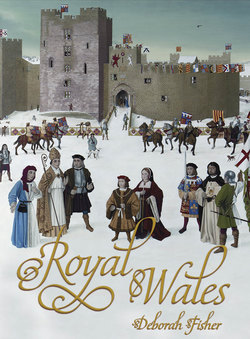Читать книгу Royal Wales - Deborah Fisher - Страница 10
На сайте Литреса книга снята с продажи.
ОглавлениеIntroduction
When King Edward I brought about the death of the last independent prince of Wales, he was eliminating a royal family with which he had close blood ties. Llywelyn’s late wife, Eleanor de Montfort (1252–82), had been Edward’s first cousin. Llywelyn’s uncle and predecessor, Dafydd, had been another first cousin. Llywelyn’s aunt, Gwladus Ddu, had been married to Ralph Mortimer, lord of Wigmore, a Norman whose forebears had served Edward’s ancestor, William the Conqueror, and had done well out of the invasion of England. The Mortimers had also intermarried with the English royal family, and several of their descendants would have a pivotal role to play in the future of Anglo-Welsh relations.
It was not unusual, in the Middle Ages, for close family ties to be ignored when political issues came to the fore. Just as families today may fall out over things like wills, divorce and the custody of children, so royal families in the past have squabbled and have even resorted to systematic elimination of their nearest and dearest in order to reinforce their own position. The Welsh were not above the same practice. After the death of Owain Gwynedd in 1170, his sons famously fought one another for dominance, the overall winners being ‘Cristin’s brood’, the children of Owain’s charismatic second wife. This being the case, we should hardly be surprised at the suffering English kings were prepared to inflict on their rival rulers across the border.
Throughout the Middle Ages and afterwards, not only in England and Wales but worldwide, marriages between the members of royal and noble families were made for political reasons. The idea was that the children of such marriages would inherit the parents’ titles and property and that their kingdoms, principalities, fiefdoms or other types of territory would thereafter become firm allies. It seldom worked that way in practice. In Wales, rulers of small individual kingdoms were handicapped by the tradition of dividing their inheritance equally between all male children (including the illegitimate ones). Occasionally, they got around this by marrying off their sons to the daughters of other rulers, thus enabling kingdoms of a comparable size to be created. This was how men like Rhodri Mawr (c.820–78) and Hywel Dda (c.880–950) succeeded in becoming ‘kings’ of most of what we now call Wales.
Royalty, for many people today, is a dirty word. Republicans see it as a symbol of oppression, a legacy of the times when physical power and inherited privilege decided who held sway, times when the greatest happiness of the greatest number was not even a peripheral consideration. For others, even in Wales, the word ‘royalty’ embodies all that is great about the island of Britain. It symbolizes tradition, permanence and pageantry. This is not a new phenomenon; the royal families of the now United Kingdom, like those of other monarchies, have always had an ambivalent relationship with their subjects. This book examines where Wales fits into that picture.
The customs, traditions and government of the principality are in many ways inseparable from those of the UK as a whole, yet their origins in the activities of our royal families are often ignored. It is no accident that we have a prince of Wales, a Royal Welsh regiment and a Royal Welsh Show, that our towns and organizations are proud of their royal charters, that royal wedding rings are made from Welsh gold.
Unlike my two previous books published by University of Wales Press, Princesses of Wales and Princes of Wales, this book does not attempt to tell the stories of people’s lives. Its goal is to explore the meaning of the word ‘royal’ in the context of Welsh life, uncovering unexpected connections and revealing how, even in the present day, the British royal family is indissolubly linked with its Welsh subjects. Our past has been heavily influenced by the royals; could it be that their future depends on us?
